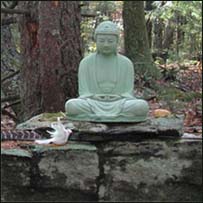|
|
 |
Please support Dharma Seed with a 2025 year-end gift.
Your donations allow us to offer these teachings online to all.

|

|

|
The greatest gift is the
gift of the teachings
|
|

|
| |
|
Dharma Talks
in English
|
2025-10-25
Acceptance
1:27:32
|
|
Ayya Santussika
|
|
|
This guided meditation, dhamma talk, questions and responses was offered on October 25, 2025 for “How do I apply the Dhamma to THIS!?!”
00:00 - Guided Meditation
16:44 - DHAMMA TALK
28:20 - Q&R
|
|
Karuna Buddhist Vihara
|
|
|
2025-10-22
Q&A
43:11
|
|
Ajahn Sucitto
|
|
|
Q1 In sitting meditation I have much less distraction but I feel a sense of torpor. Where does this come from and how can I deal with it? 07:10 Q2 I spend the majority of my life trying to ignore my difficult emotions. Since I began meditation I’ve tried to welcome them all but they take a lot of space. Will it be like this the rest of my life? [A similar one:] I find myself in a deep groove of negativity which is hard to shift. After a couple of decades of practice I am embarrassed by this and find myself more and more isolated from family and friends. [A similar one:] I was bullied as a young teenager which destroyed my self-esteem. How can I secure my heart? 17:20 Q3 Can you explain the difference between citta and consciousness? [A similar one:] How can citta be experienced best? Is it only through phenomena? Can citta be satisfied by internal content and does this help to ease the thirst for sensual gratification? 28:18 Q4 I find it very difficult to do chanting because of difficulty with my throat feeling clogged. 30:20 Q5 My son has had long covid for 4 years and started getting panic attacks. Can you comment please. 33:30 Q5 My question is about violence – not just corporeal violence but also including gossip, jealousy etc. Can you speak to these please?
|
|
Moulin de Chaves
:
The Mind Writes, the Heart Sings
|
|
|
2025-10-22
Bringing Our Practice to Challenging Conversations and Communications, Including with Those with Different Views and Perspectives 2
64:23
|
|
Donald Rothberg
|
|
|
We continue the exploration from last week, beginning with Donald sharing a few of his experiences of being able to learn and practice when there have been differences of views and even conflicts. Then there is a review of some what we explored last week, including the importance in a functioning democracy of navigating differences of views, some of the factors making that harder in current times, and some of the practice supports for conversations when there are different views—both inner and outer (especially related to wise speech practice). We go further into exploring inner practices helpful when there are differences, including working with reactivity and difficult emotions, exploring views and options, and then the integrated inner and outer practice of cultivating empathy as a practice. The talk is followed by discussion, including several people sharing their own explorations with challenging conversations in the last week.
|
|
Spirit Rock Meditation Center
:
Monday and Wednesday Talks
|
|
|
2025-10-21
Q&A
41:07
|
|
Ajahn Sucitto
|
|
|
Q1 I couldn't keep up with this morning's talk. Could you talk about the meaning of kalyana? Q2 04:20 What can we doing instead of getting rid of stuff that bothers us? 09:49 Q3 my inner tyrant has been very active. What is it and how can I deal with it? 14:32 Q4 What does "sitting with emotions" mean more concretely? It feels a bit abstract. 22:26 Q5 Is there something like embodied thinking? In other words, how to reflect upon my meditation when words are sankaras? 25:33 Q6 How to create a more permanent sense feeling of safety in the body? 29:28 Q7 My mother has dementia and refuses to acknowledge her situation. She recently fell and broke her hip. My father is struggling to maintain himself, trying to do the best he can. I'm deeply touched by this situation. How can I best integrate this into my practice? 40:20 Q8 Sometimes in QiGong practice I feel a little nauseous. Can you comment please?
|
|
Moulin de Chaves
:
The Mind Writes, the Heart Sings
|
|
|
|
|